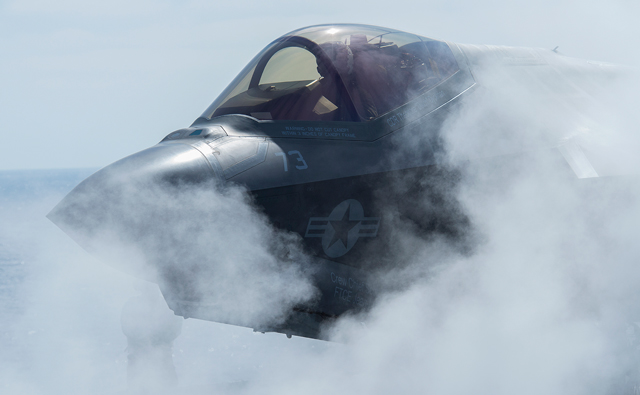The Lockheed Martin F-35 appears to be overcoming many of the software troubles that have dogged the programme since its inception, but the fighter jet’s complexity means that any attempt to squeeze extra capabilities into early software blocks would threaten the wider rollout schedule.
That has been the experience of the US Navy, which asked the joint programme office (JPO) to consider bringing forward delivery of the wide-area search radar function to Block 3F, but then quietly withdrew the request.
“A request was made to investigate expanding the Block 3F radar techniques to include wide-area search, which was not an original requirement for the 3F capability,” the F-35 JPO explained in an email.
“Implementing this capability in Block 3F would have incurred a significant schedule impact, and would have also required an integration of a new weapon capability to fully deploy the anti-surface warfare mission improvements. Based on this, the warfighter decided to include it in Block 4.1, which will be delivered in 2019.”
The US Navy intends to buy hundreds of carrier-based F-35Cs over the coming decade to replace its legacy F/A-18 Hornets, and is on track to declare initial operational capability with 10 combat-coded jets equipped with Block 3F software in August 2018.
Upon delivery, those aircraft will be capable of finding and tracking ships and other maritime targets using their Northrop Grumman active electronically scanned array (AESA) radars, but with a far narrower field of view than will be possible with the wide-area search function. Wide-area search, also known as "Big SAR," was being considered as a baseline capability for the F-35 as far back as 2007, but did not make the cut when Block 3F was defined.

US Navy
The radar capability’s “deferral” was disclosed in a software development report sent by the Pentagon to US lawmakers in June.
The DOD says in the report that F-35 software development and integration remains a key concern, but the programme “is on the right track and will continue to deliver on the commitments made to the F-35 enterprise” – which includes partner nations and foreign military sale customers . That goes for both the aircraft itself and the troubled Autonomic Logistics Information System (ALIS) that supports it, according to the report.
The report says Block 2B – which the Marine Corps declared IOC with in July – has eight unresolved issues that centre on “sensor fusion, electronic warfare and Link 16 communications,” although those problems “do not interfere with the USMC IOC mission sets” and will be resolved in Block 3F – which Lockheed has already begun flight testing.
The US Air Force, meanwhile, has identified six Block 2B software deficiencies that it needs resolved prior to its IOC declaration with the A-model in August 2016. Those aircraft will be fielded with Block 3i software and a faster computer processor.
“The air force requested improvements in the software to provide clear and timely information concerning the health and status of various sensors on the aircraft,” the JPO says. “The improved software will inform pilots of immediate degradation of the mission system core computers, the radar processing computers, and the tactical situation display.
“The improvements will also provide clearer indication of the field of regard for the radar, and the prioritization of targets. Computer enhancements will also be made to speed up the download times of post-flight data.”
Despite being years behind its original schedule and billions of dollars over budget, the F-35 programme has mostly been meeting its revised targets set in the 2012 re-baselining. The programme is just over 60% of the way through its test programme, and new technical issues could still surface.
But perhaps the biggest programmatic risk at this point is cost. The annual funding requirement is expected to peak at $14 billion in 2022, according to the US Government Accountability Office, and the services plan to spend $54 billion buying 339 aircraft through 2019.
The Pentagon is currently re-assessing its F-35 requirement of 2,443 aircraft, and the navy is considering reducing the number of F-35Cs it will buy each year.
Source: FlightGlobal.com



















